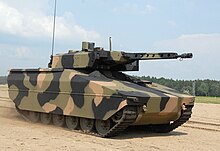Lynx (Rheinmetall armoured fighting vehicle)
One of the key principles of the Lynx concept is the integration of proven sub-systems with a high technology readiness level to reduce development time, cost and technical risk.
[4] The Lynx family has been designed as a highly protected tracked armoured vehicle to fill a gap identified in the market by Rheinmetall.
Lynx was designed as a private venture by Rheinmetall to provide customers with a modern fighting vehicle that will be able to counter emerging near peer threats whilst maintaining the ability to conduct asymmetric or peace-keeping operations.
On 4 June 2018 Rheinmetall issued a press release informing that the larger Lynx KF41 would debut in two different configurations at the upcoming Eurosatory defence exhibition later that month.
It consists of a Lynx KF41 hull mounting a large-calibre crewed turret armed with a derivative of Rheinmetall's 120 mm smoothbore gun family.
[8] The Lynx's overall design layout is conventional, the front right located powerpack consisting of a Liebherr six-cylinder inline diesel engine coupled to either an Allison X300 series 6F/1R or Renk HSWL 256 automatic transmission.
The running gear has six road wheel stations per side, which guide a lightweight steel or segmented rubber band-type track.
[10] Mobility parameters will vary by variant and exact configuration but are stated to include a maximum road speed of 70 km/h, a gradeability of at least 60%, a sideslope traverse capability of at least 30%, the ability to climb (forwards) a 1 m vertical obstacle, the ability to cross a 2.5 m trench, and an unprepared fording depth of 1.5 m. Operational range on 900-litres of diesel fuel is 500 km.
The rear crew compartment is designed as a mission neutral space with the incorporation of C-rails and a pattern of universal fixing points on the walls and floor.
[11][10] For the CSV variant the most prominent design change is the removal of the turret and the alteration of the rear of the vehicle to provide a lowered loadbed for cargo to be transported on.
The remaining internal volume below the loadbed is understood to house additional fuel tanks and storage for specialist equipment.
The vehicle's ballistic steel armour is designed to protect the Lynx from anti-tank weapons, medium-caliber ammunition, artillery shrapnel and bomblets, although exact details are classified.
[12][13][10] The standard armour configuration is designated the Mounted Combat Operations (MCO) kit and it is intended to offer vehicle protection against similarly armed opponents.
[8] Additional active protection can be provided for shaped charge warhead attack using Rheinmetall's Strike Shield APS.
The Lynx family of tracked armoured vehicles is based around two primary models, the KF31 and a slightly larger but considerably heavier KF41.
[15][16] This model, first displayed at Eurosatory 2016, has a maximum permissible gross vehicle weight of 35 to 38 tonnes, is 7.22 meters long[11] and can carry a crew of three plus six passengers.
